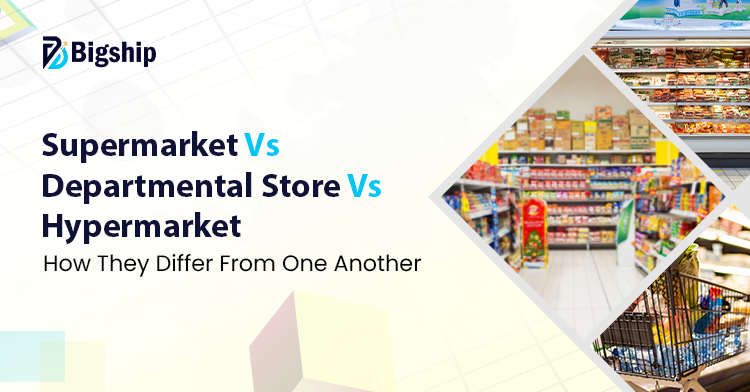Shopping is an essential part of everyone’s life. We often step into supermarkets, departmental stores, or hypermarkets without giving much attention to how they differ from one another. Each of these retail formats serves unique purposes and addresses various shopping needs.
For shoppers like you and me, knowing the difference between supermarkets and hypermarkets, and also department stores can lead to smarter shopping decisions. Businesses, too, benefit from recognizing these differences, as it helps them refine their offerings.
In this blog, we’ll explore what sets these three apart and their pros and cons.
What Do You Mean By a Supermarket?
A supermarket is a large retail store that offers a variety of products under one roof. It focuses primarily on groceries, household items, fresh produce, and dairy products. These stores also stock snacks, packaged foods, and even frozen goods to meet the diverse needs of shoppers. Supermarkets are designed to serve both individual and family shopping needs.
The store layout of a supermarket is planned to ensure convenience and ease for shoppers. Products are arranged in different aisles based on categories, allowing customers to quickly locate and pick up items they need. Shoppers often use carts or baskets to move around the store by making it a smooth experience. The self-service model helps save time and makes shopping more efficient.
Popular examples of supermarkets in India include Reliance Fresh, Easy Day, and Suvidha Stores. These stores are spread across various cities and offer competitive prices by attracting a large number of customers. Whether it’s a weekly grocery run or stocking up for the month, supermarkets have become a go-to destination for many households.
What Do You Mean By a Department Store?
A department store is a large retail establishment that offers a wide variety of products under one roof, organized into separate sections or departments. Each department focuses on a specific product category, such as clothing, home appliances, electronics, or cosmetics, and many more. This makes it convenient for customers to find everything they need in one place.
The layout of a department store is designed to cater to diverse shopping needs, with sections clearly marked for easy navigation. These stores often feature a mix of high-end and budget-friendly products. Such stores often attract a wide range of customers. Department stores provide a comprehensive shopping experience for everyone by providing a wide variety of apparel, accessories, kitchenware, furniture, etc.
In India, examples of department stores include Shoppers Stop, Store 99, Lifestyle, and Pantaloons. These stores are popular for their extensive collections and customer-friendly services.
What Do You Mean By a Hypermarket?
A hypermarket is a large retail store that combines the features of both a supermarket and a department store. It offers an extensive range of products, which includes groceries, fresh produce, electronics, clothing, furniture, household essentials, and more. Unlike smaller retail formats, hypermarkets are designed to provide a one-stop solution for all shopping needs. Such superstores are ideal for those looking for variety and convenience in one location.
These stores often feature spacious layouts with dedicated sections for different product categories, thus, allowing customers to shop with ease. Some hypermarkets also include additional facilities like cafes, or food courts, and encourage shoppers to spend more time inside. This mix of retail and leisure enhances the overall shopping experience and caters to a wide audience.
In India, hypermarkets like Big Bazaar, Vishal Mega Mart, Reliance Mart, and Spencer’s Hypermarket are popular examples. These stores are located in major cities and are known for offering a vast assortment of products at competitive prices. Hypermarkets combine affordability with convenience which makes them a preferred choice for consumers.
Distinctions between Hypermarket Vs Supermarket Vs Department Store
The difference between supermarket and hypermarket and department stores lies primarily in their size and product range. While supermarkets cater to daily essentials, hypermarkets aim to be a comprehensive shopping destination.
The table below gives a better understanding of each of these shopping stops.
| Supermarket | Department Store | Hypermarket |
| A supermarket typically covers a single floor and is designed for self-service shopping. | A department store is usually bigger, often spread across multiple floors, with sections for various categories of goods. | A hypermarket is usually the largest of the three, as it combines features of supermarkets and department stores. |
| In supermarkets, you will find groceries, fresh produce, and some household essentials. | In department stores, you can explore a wide variety of sections like clothing, electronics, jewelry, home goods, etc. | A hypermarket provides everything from groceries to clothing, electronics, furniture, and sometimes additional facilities like cafes as well. |
| Supermarkets use everyday low pricing or promotions to attract customers. | In department stores, you will find products that are priced higher as they focus on quality and variety. | Hypermarkets offer lower prices due to bulk sales and high negotiation power with suppliers. |
| Supermarkets are for everyday shoppers looking for essential household items, usually ration. | Department stores appeal to shoppers seeking premium or specialized products in different categories. | Hypermarkets attract families and bulk buyers looking for a one-stop solution for all their shopping needs. |
| Supermarkets often provide sales assistants for a smooth and convenient shopping experience. | In department stores, you will get a more personalized shopping experience with staff assistance for each section. | Hypermarkets provide self-service shopping with carts and minimal staff intervention. |
Benefits and Drawbacks of Supermarkets, Department Stores, and Hypermarkets
Department stores, supermarkets, and hypermarkets are popular retail formats, each offering distinct advantages and disadvantages. Let’s have a look at the benefits and drawbacks of each.
Advantages of Supermarkets
Variety of Choices: Supermarkets generally stock a broad range of products, because of which customers can easily find what they need without compromising. For example, if a person is looking for instant noodles, he or she can find plenty of options for the same.
Convenient Layout: Most supermarkets are designed to provide a hassle-free shopping experience, with goods organized in clearly marked aisles.
Transparent Pricing: Supermarkets typically use fixed pricing. This way customers can shop without haggling or feeling unsure about costs.
Drawbacks of Supermarket
Easily Perishable Food Items: Supermarkets often stock large quantities of perishable items like fruits, vegetables, and dairy. Unsold goods may spoil and still remain on shelves and this can lead to customer dissatisfaction.
Self-Service Challenges: Supermarkets rely on self-service. In such a case, customers unfamiliar with certain products may struggle to make informed choices.
Advantages of Department Stores
High-Quality Products: Departmental stores prioritize quality, often offering premium or branded products that provide value for money.
Personalized Assistance: Experienced staff are available to help shoppers which makes it easier for customers to find and choose products.
Excellent After-sale Support: These stores are known for their after-sales services and customer support. Be it warranties or repairs, departmental stores ensure customer satisfaction.
Disadvantages of Department Stores
Higher Costs: Departmental stores often charge higher prices than supermarkets or hypermarkets as their focus is on quality and additional services like parking or restrooms.
Advantages of Hypermarkets
Competitive Pricing: Bulk buying allows hypermarkets to negotiate lower prices from suppliers, thus offering products at lower prices to customers.
All-in-One Shopping Experience: Hypermarkets are ideal for customers looking for a single destination for groceries, household items, electronics, and more. With everything available under one roof, shopping becomes convenient and time-saving.
Extended Operating Hours: Usually hypermarkets operate for longer hours, with some open 24/7. This flexibility is especially useful for those who have busy schedules or need last-minute items.
Disadvantages of Hypermarkets
Inconvenient Locations: Hypermarkets are often located on city outskirts due to their large space requirements.
Minimal Customer Assistance: Hypermarkets focus on self-service, which may not suit customers who need guidance while shopping.
Role of E-commerce in Modern Retail Formats
E-commerce is reshaping modern retail formats like supermarkets, department stores, and hypermarkets by blending offline and online shopping. It allows stores to offer hybrid models such as click-and-collect and home delivery. This provides convenience to the existing customers as well as a broader reach.
For example, customers can order groceries online from a supermarket and pick them up in-store or get them delivered to their doorstep. Similarly, hypermarkets and department stores use e-commerce platforms to showcase diverse products and attract more customers with exclusive online offers.
Conclusion
One can make shopping more efficient if one knows the differences between supermarkets and hypermarkets, along with department stores. Each of these formats serves a purpose. Supermarkets are great for daily essentials, hypermarkets offer everything in one place, whereas, department stores focus on quality.
You should consider what matters most to you, such as variety, pricing, or convenience. For quick grocery runs, supermarkets work well. Hypermarkets are ideal for one-stop bulk shopping, while departmental stores are perfect for premium products and excellent after-sales support. Therefore, choosing the right option depends on your shopping needs.
FAQs
How does a supermarket differ from a hypermarket?
The main difference between a hypermarket and supermarket lies in their size and offerings. A hypermarket is much larger and combines a supermarket with additional sections like electronics, clothing, and household goods. Supermarkets, on the other hand, focus mainly on groceries and everyday essentials.
Which option is better, a hypermarket or a supermarket?
The hypermarket vs supermarket choice depends on your needs. Hypermarkets offer a wide range of products, including groceries, electronics, and clothing, usually at lower prices, but are located farther out. Supermarkets mainly offer groceries and daily essentials and are often more conveniently located in residential areas.
How do hypermarkets keep their prices low?
Hypermarkets buy products in bulk which allows them to negotiate better deals with suppliers. This further lets them offer products to general public at lower prices.





